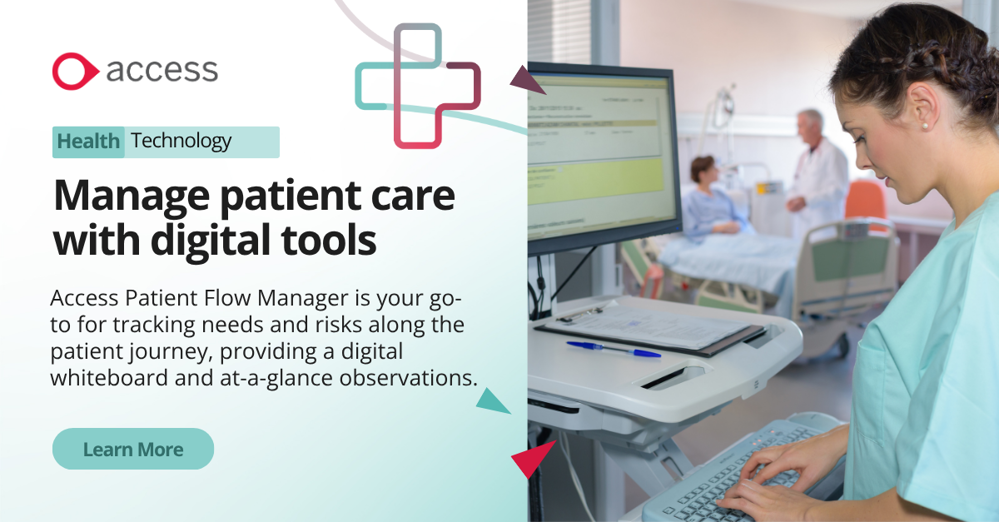
How to improve patient flow
The best way to improve patient flow is through research and informed actions in response to the evidence. Experts should assess how to improve patient flow by studying patient flow management in action, and this is exactly what has happened and continues to this day.
A report from The Health Organisation, published April 2013, detailed findings from South Warwickshire NHS Foundation Trust and Sheffield Teaching Hospitals NHS Trust. The Health Organisation created their own Flow Cost Quality improvement programme to assess flow, costs, and care outcomes within these two case studies. They wanted to see how to improve patient flow in emergency departments as well as other hospital departments. They queried issues such as why patients see junior clinicians first and then wait on senior involvement, are assessment units actually providing fast-tracked care or acting as holding bays, and whether discharge assessments need to be done in the hospital if a patient is well enough to go home and be assessed in a more comfortable setting.
The evaluation work showed that patient flow was lagging with regards meeting real-time demand but also multidisciplinary assessment; too much of the patient assessment was fragmented. People having to see one team, then the next, then the next, and maybe they then have to go back to a previous unit. The recommendations were understandably to improve the “turnaround time of core processes”, and to “improve the flow into post-discharge care”.
This ties in with testimonies given to The Access Group by numerous NHS trusts and teams across the UK. Teams then and now are still facing the same issues regarding the turnaround of core processes; lots of phone calls, meetings, the use of spreadsheets... but bed capacity management flags higher now than it perhaps did a decade ago.
The population has grown, bed availability has not matched the rate as a percentage, and private beds are being used in some cases to create more capacity. This is a huge cost – an average of £680 per bed per day – and adds up to £15 million per year for just 60 beds; an unsustainable figure. Greater patient flow efficiency could help with the bed capacity issue and remove these drastic costs which are especially damaging to the community and mental health Trusts often utilising them in lieu of hospital bed availability.
Another core issue not covered in as much detail in 2013 as it would be in 2023 is software solutions. Spreadsheets were at one time the best option, but they were a temporary solution whilst better programs were developed. Those programs now exist and should be utilised. Monitoring patients is hard without appropriate healthcare software to provide live updates and role-based access to patient notes and the updating of said information.
The lack of updates is why staff are having to make so many phone calls, but it also restricts the bed availability. Spreadsheets can’t coordinate with other software like bespoke healthcare tools can. There’s a known increase in demand in the post-Covid society we are in. More patients than ever need NHS support, but the demand means acute beds are used.
This isn’t appropriate to some patients and even puts them at greater risk, whilst others suffer from delays to urgent treatment. Outdated computer programs like spreadsheets are a hindrance now, and serve little more advantage than a whiteboard with marker pens. Both are a slow and clumsy way to provide information to clinicians; taking up vital time that could be used on assessment and treatment.

Conclusions to act upon:
We know discharge has been acted upon in the past decade and Discharge to Assess is a topic we at Access have written about. The other conclusions about ways to improve patient flow were intriguing though. The 2013 investigation concluded that demand was fairly predictable regarding illness, but delays from GP assessment and transport/travel meant that most of the escalation within a hospital setting was taking place in an afternoon, which then was impacted by the rostering of senior staff who might be on early or standard shifts and would be clocking off by 6pm latest.
There were also issues with queues forming over weekends, which then caused a lag on Mondays, as well as the risk of some being put onto the wrong care pathway over a weekend due to the desire to minimise the overspill from weekend to weekday. Sheffield noted this impacted outpatients just as much as A&E, albeit over a longer time period due to the infrequency of visits, whilst South Warwickshire highlighted the signs of correlation between poor patient flow and higher mortality rates – indicated in their statistics by a rise in emergency access target breaches.
There were also issues regarding the speed of flow and discharge that were attributed by both NHS trusts to the local healthcare system and interdependency therein, with elements like the closure of a community hospital out of the control of a primary hospital but still forcing extra patients to them for care and support.
In response, Sheffield and South Warwickshire (respectively) improved patient flow by:
- Better organising of consultant hours
- Better organising of junior doctor hours and usage
- Allowing consultants greater freedoms to see patients and progress care
- Greater data analysis
- More stakeholder communication
- Faster medical processes (e.g. blood tests)
- Electronic work management systems for smarter organisation
- Daily ‘ward and board’ rounds (since digitised nationwide)
- Easier take-home medicine process
- Discharge to Assess (home assessment post-hospital stay)
- Greater self-assessment via process mapping, patient stories, and patient note reviews to build patterns of what or who slows patient flow and why.
With a focus on improving patient flow, both trusts adjusted consultant working patterns, meaning more capacity was available in line with the demand for specialist input. Each team also went further in other areas. Sheffield developed an Integrated Frailty Unit, to see people on the day they arrived requiring care and to put previously seen patients into either outpatient or emergency care, depending on needs. South Warwickshire created a system where specialists could pull their patients from the Medical Assessment Unit to speed up the process of diagnosis and assigning a person to an appropriate care pathway.
The ‘back door’ (exit) of patient flow from hospital to community setting had made very limited progress at the time – due to the aforementioned lack of control – but it did lead to greater data analysis and stakeholder communication.
We should remember that this report is 10 years old and many new software solutions and best practices have since been introduced on a national scale as a result of case studies such as this one. Technologically speaking, 2013 saw the release of the iPhone 5s. We’re now on the iPhone 14 series. Nobody would look at that older model and be impressed, so it’s only fair we adjust our expectations of previous healthcare environments. We should also applaud how many things these two trusts – with the researchers investigating - pointed out that are being acted upon in the present day.
The reality now is that healthcare providers need to be utilising things such as the NHS assured supplier lists to see what software solutions are available and the healthcare tasks they perform, so that they can engage with a supplier, onboard the necessary solution, and revolutionise their care to save both time and money whilst generating better care outcomes.
Improving patient flow NHS
We now know how to improve patient flow in hospitals, but the NHS is has much more to it than just being hospitals. We also need to know how to improve patient flow in clinics, about the importance of optimising medicines discharge to improve patient flow, and to what extent using tracking tools to improve patient flow in hospitals is beneficial.
Health Tech Newspaper has an article from August 2023 polling what organisations need most to improve patient flow. Available to users on Twitter and LinkedIn, voters came from backgrounds within NHS organisations (nurses, programme managers, clinicians), as well as including researchers and healthcare innovators. The results were as follows:
- 36.5% said more workforce capacity is needed
- 31.7% said access to real-time data
- 21.9% said more funding for digital technology
- 9.75% said better identifying gaps
This tallies with our previous case study in that the gaps have, for the most part, been identified. New ones may appear with broadening care remits, or in niche circumstances, but generally consensus has been established.
Improving patient flow in the NHS needs more staff, which will surprise nobody when considering a BBC News article from July 2022 in which MPs warned of a staffing crisis in NHS England and a serious risk to patient safety.
It’s important to note that the combination of real-time data and digital tech funding outweighs staffing needs, but as individual claims this stands clear as the first priority. A lot is said about the important of software solutions in healthcare, and The Access Group as a provider of said solutions will always advocate the benefits of good tools to enable better care, but healthcare is nothing without carers to help the individual. A computer programme isn’t of any use unless there are capable, trained staff members available to utilise these solutions.

Strategies for improving patient flow
This brings us to the strategy section of the article; how to actually go about improving patient flow in hospitals. There are five key strategies for improving patient flow:
- Better organisation of clinical staff shifts (rostering)
- Reduced delays in associated services (e.g. blood testing)
- Introduce new or better software solutions
- Recruit more staff
- Better oversight of capacity and demand to improve planning
Regardless of whether you’re improving patient flow in an emergency department or improving patient flow in outpatient clinics, there has to be top-down action to enact the more serious and impactful change. Calls for aid from NHS trusts and other bodies – such as integrated care systems (ICS) – should help the cause but ultimately there needs to be executive action. It is the duty of NHS England to petition the government for more funding, or budgetary adjustments, to allow greater recruitment and the necessary advertising push to make vacancies known.
It doesn’t entirely fall on the top body though. It is the duty of regional health bodies to encourage appropriate digitisation and the onboarding of software solutions. It is the duty of NHS trusts to handle the organisation of staff, such as the consultant shift changes we referred to previously, or the pooling of junior doctors to improve the assessment rate of daytime cases, or the optimisation of internal processes. The frontline is in the hospital setting, and the strategy has to be to keep the patient flow process as simple and coherent as possible for all staff members, so that as little time is wasted processing patients through the system and onto the right care pathways.
The best strategies are options 1 to 3, but funding is not a guarantee within the NHS. Budgets are tighter than ever, inflation is high, and the backlog of elective care post-Covid is a hindrance. Improvements on the frontline can still have a positive impact on care provision and healthcare professionals alike though and can buy time to raise funds to support healthcare software – especially when considering that digitisation is a core priority for the government and NHS alike in an ever more technology-led society.
With an integrated software solution you can have real-time updates, meaning there’s less need for long meetings and more time for actual care. People are seen quicker, care is more effective, patients are put onto the correct pathways before they stack up in waiting rooms and wards.
Efficiency also applies to hindrances like phone calls and chasing up information too, as the software can interoperate with other solutions to bring in important information. Patient data is protected as per legal guidelines and clinical regulations, and the live visibility of patient locations and ward capacity helps the juggling act of optimised bed and staff usage.
From a managerial perspective, less money is spent on private beds, you achieve greater patient and staff satisfaction, a reduction in staff turnover and burnout due to intense workloads, easier reporting, and the assessment and referral process is simpler for the administrative side of care.
Digital healthcare solutions, such as our very own Access Patient Flow Manager, require investment over time, but the investment will free up funds elsewhere in the system by bringing new-found efficiencies and greater care outcomes.

 AU & NZ
AU & NZ
 SG
SG
 MY
MY
 US
US
 IE
IE

